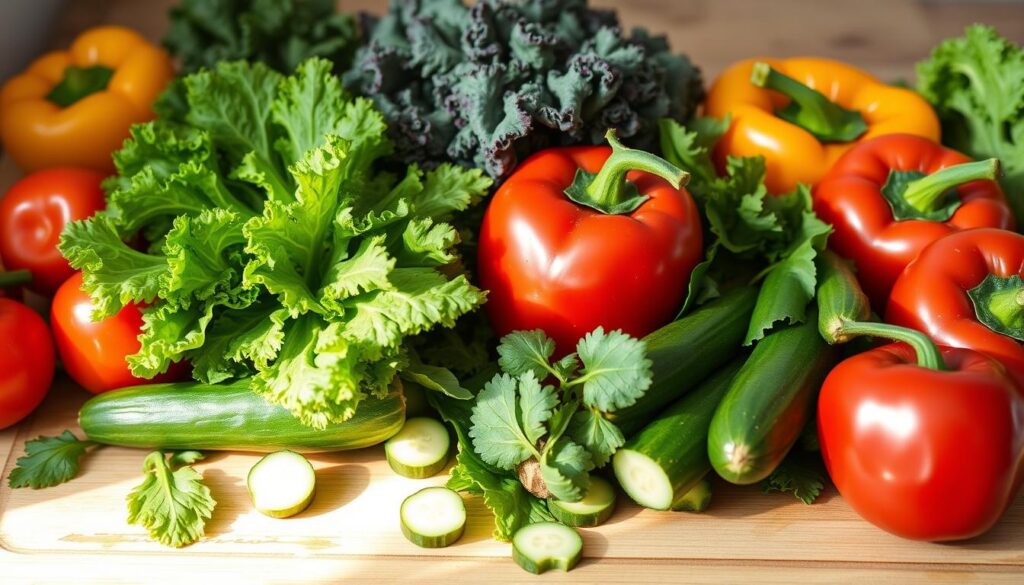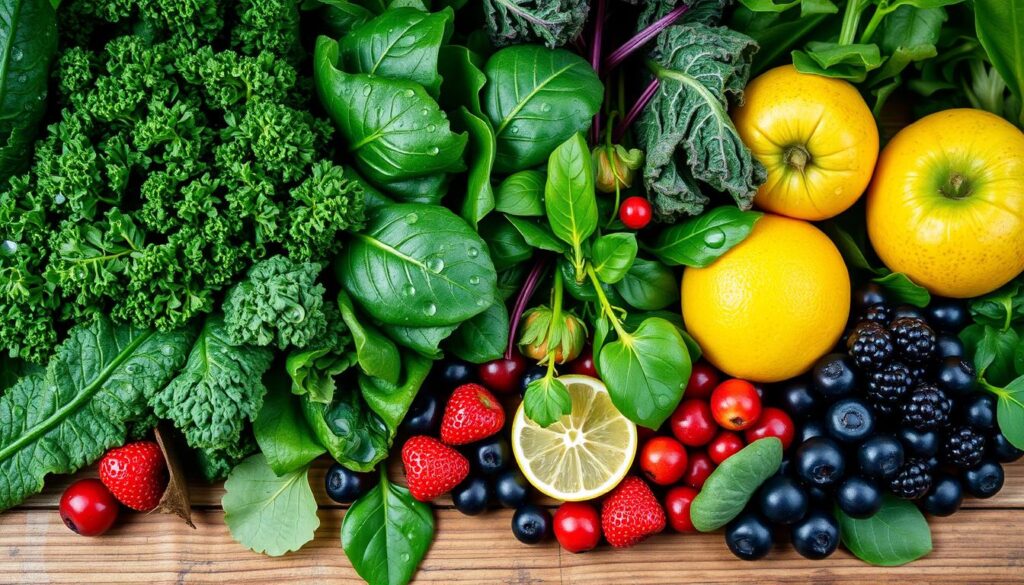Healthy Diabetes and Juicing Recipes for Blood Sugar
Managing diabetes can be tough. Finding ways to keep blood sugar levels healthy is key. Juicing can be a big help if done correctly. It’s not just about drinking juice; it’s about getting the nutrients your body needs.
Contrary to what some think, fresh juices can actually help control your blood sugar. They support your health in many ways. In this article, you’ll find diabetic-friendly juice recipes (diabetes and juicing recipes ) that taste great and help keep your blood sugar in balance.
Key Takeaways
- Discover the benefits of juicing for diabetes management
- Learn about the best low-glycemic fruits and vegetables for diabetic juicing
- Explore delicious and healthy juice recipes tailored for individuals with diabetes
- Understand the importance of incorporating juicing into your overall diabetes care plan
- Discover how juicing can help regulate blood sugar levels and support your health goals
Understanding the Connection Between Juicing and Diabetes Management
If you have diabetes, adding fresh juices to your diet can help control blood sugar. It’s key to know how juicing impacts glucose levels. Also, picking the right ingredients is vital for keeping blood sugar steady.
Benefits of Fresh Juices for Blood Sugar Control
Fresh juices can be a great help in managing diabetes if made right. Some fruits and veggies are low in sugar and high in fiber. This slows down carb absorption and prevents blood sugar spikes.
Juicing for diabetes type 2 recipes with leafy greens, low-sugar berries, and non-starchy veggies are good. They boost nutrient intake while keeping blood glucose stable.
How Juicing Affects Glucose Levels
The effect of juicing on blood sugar depends on the ingredients. Is juicing good for diabetics? Yes, but with some conditions. Juicing can be healthy for diabetes management, but drinking too much fruit juice can quickly raise blood sugar.
To avoid this, limit juice to 4-6 ounces. Mix it with low-glycemic foods like veggies, herbs, and spices.
“Diabetic women who drank 40mL of concentrated tart cherry juice for six weeks were able to lower their HbA1C and fasting blood sugar levels.”
By picking the right ingredients and watching portion sizes, juicing can be a good part of a diabetes-friendly diet.
Fruits and Vegetables to Avoid in Diabetic Juicing
When making juices for diabetics, it’s key to watch what fruits and veggies you use. Some have a lot of sugar, which can make blood sugar go up too fast. Knowing which ones to avoid or use less of is important when making the best green juice for diabetics.
Fruits like bananas, pineapples, and grapes have a lot of sugar. They can give you 13-20 grams of carbs per 100 grams. This can quickly increase your blood sugar. Also, dried fruits are sweeter because they lose water, so you should eat them in small amounts.
- Bananas
- Pineapples
- Grapes
- Dried fruits
Even though fresh fruits can help prevent diabetes and heart disease, choose low-glycemic ones for juicing. Using frozen fruits like mashed banana slices can be a better dessert option.
When making juices for diabetes, focus on fruits and veggies that are full of nutrients but have fewer carbs. Adding protein, healthy fats, and fiber can also help control how juice affects your blood sugar.

It’s important to know the glycemic index of different foods and control how much you eat. This helps make juices that help keep blood sugar healthy for people with diabetes.
Best Low-Glycemic Ingredients for Diabetic Juice Recipes
Managing diabetes through juicing means choosing low-glycemic ingredients. These won’t raise your blood sugar. You can use leafy greens, low-sugar fruits, and veggies to make tasty, diabetes-friendly juices.
Leafy Greens and Their Benefits
Leafy greens like spinach, kale, and collard greens are great for diabetic juicing. They’re full of nutrients but low in carbs. They’re also rich in fiber, vitamins, and minerals that help control blood sugar.
Spinach, for example, is full of magnesium. Magnesium helps with insulin sensitivity and glucose metabolism.
Low-Sugar Fruits Safe for Diabetics
Fruits can be part of a diabetic’s diet, but pick low-sugar ones. Berries, kiwi, and grapefruit are good choices. They’re full of fiber, vitamins, and antioxidants without raising blood sugar too much.
Beneficial Vegetables for Blood Sugar Control
Vegetables like cucumber, celery, and carrots are great for diabetics. Cucumber is hydrating and low in carbs, helping control blood sugar. Celery is full of antioxidants and may improve insulin sensitivity.
Carrots are a good source of fiber, vitamin A, and beta-carotene. These support health and blood sugar management.
Using these low-glycemic ingredients in your juicing can be healthy without affecting blood sugar. Try different mixes to find your favorite cucumber juice recipes for diabetics and best green juice for diabetics.

Essential Equipment for Making Diabetic-Friendly Juices
Making tasty juices at home that are good for diabetics needs the right tools. Choosing the right juicer is key for juicing for diabetics and managing blood pressure. Let’s look at what to consider when picking the best juicer for you.
Cold-Press Juicers: Preserving Nutrients
Cold-press juicers, also known as masticating or slow juicers, are great for diabetic juicing. They use a slow grinding motion to get juice, keeping nutrients fresh. This gentle method keeps important vitamins and minerals in your juice, helping control blood sugar.
Centrifugal Juicers: Faster but Less Nutrient-Dense
Centrifugal juicers spin fast to separate juice from pulp. They’re quicker but might lose some nutrients due to oxidation. If you need speed, a centrifugal juicer could work for you.
It’s important to clean and take care of your juicer well. Good maintenance keeps your juicer working well and saves nutrients in your juices.
| Juicer Type | Nutrient Preservation | Oxidation | Ideal for Diabetics |
|---|---|---|---|
| Cold-Press | High | Low | Yes |
| Centrifugal | Moderate | High | Moderately |
Choosing the right juicer and keeping it clean ensures your juicing journey is both tasty and healthy.
Diabetes and Juicing Recipes for Daily Wellness
For diabetics, eating well is key. Adding diabetes-friendly juicing recipes to your day can really help. These recipes help control blood sugar and give you a healthy start or a midday boost.
Morning Energy Boost Recipes
Begin your day with energy from these special juice blends. They mix low-glycemic fruits and veggies to keep your blood sugar stable. Try spinach, cucumber, and apple or kale, carrot, and ginger to start your day right.
Afternoon Refresher Blends
When you feel tired in the afternoon, try these refreshing juices. They’re full of water and low in sugar, so they won’t raise your blood sugar. Try celery, lemon, and mint or tomato, basil, and cucumber for a refreshing drink.
Adding these juices to your daily routine can improve your health and manage your blood sugar. Enjoy fresh, healthy juices made just for you.
Green Juice Combinations for Blood Sugar Management
Adding the best green juice for diabetics to your daily routine can change the game for blood sugar control. Mixing nutrient-rich leafy greens with fruits and veggies low in sugar makes tasty juices. These juices are not only delicious but also packed with health benefits for diabetics.
Kale is a superfood to focus on. It’s low in calories and carbs, perfect for diabetes control. Mix kale with cucumber, which is hydrating and low in sugar. Add a bit of lemon for a refreshing tartness.
For juicing for diabetes type 2 recipes, try spinach and celery. Spinach is rich in nitrates, which can help with blood pressure. Celery helps lower blood glucose, making it great for diabetics.
- The Green Machine Juice recipe includes 2 cups of kale, 1 medium cucumber, 1 green apple, and 1/2 lemon.
- The Spicy Carrot Juice recipe has 1 beetroot, 2 medium carrots, 1/2 inch ginger, and 1/2 lemon.
- The Berry Green Reviver Juice recipe features 2 cups of baby spinach, 2 celery stalks, 1 cup of blueberries, and 1/2 lemon.
When making your own best green juice for diabetics, balance the ingredients to avoid blood sugar spikes. Use slow juicing tech, like Kuvings’, to make nutrient-rich juices easily while keeping their benefits.
“Incorporating the best green juice for diabetics into your daily routine can be a game-changer for managing blood sugar levels.”
Carrot-Based Recipes for Diabetic Health
Carrot-based juices are great for people with diabetes. Carrots have low sugar and lots of fiber. They are good for you. Here are two tasty carrot juice recipes that help control blood sugar and boost health.
Carrot and Apple Combinations
Carrots and apples make a tasty juice. Apples add sweetness, while carrots add earthy flavor. This mix is refreshing and won’t raise your blood sugar. Try this mix: 26.4 oz Carrot, 7.7 oz Red Apple, 7.7 oz Green Apple, 0.7 oz Lemon, and 0.7 oz Ginger.
Lemon and ginger add a zesty flavor. They might also help control blood sugar.
Spice-Enhanced Carrot Blends
Adding spices like ginger or cinnamon makes carrot juice warm and exciting. These spices improve flavor and might help with blood sugar. Try this mix: 4.62 oz Chard, 3.64 oz Kale, 2.44 oz Green Cabbage, 15.82 oz Green Apple, 2.66 oz Celery, and 3.56 oz Lemon.
This mix has greens, low-sugar fruits, and spices. It’s full of nutrients and supports diabetic health.
Adding carrot juices to your diet is tasty and helpful for diabetes. Try these recipes and enjoy the health benefits of diabetic juicing recipes for weight loss and natural juices for diabetics.
Cucumber and Celery Juice Recipes for Hydration
Drinking enough water is key for people with diabetes. Adding cucumber and celery juices to your diet can be a tasty way to stay hydrated. These veggies are low in calories but full of water and nutrients. They help keep blood sugar levels in check and boost your health.
The Celery Cucumber Green Juice is a favorite, with only 60 calories per serving. It’s made with cucumbers, celery, an apple, a lime, and ginger. This juice is low in sugar and rich in sodium and protein.
To make this juice, you can use a juicer or a blender. If blending, strain the juice to get rid of pulp. Drinking this juice all day helps you stay hydrated and gives you important vitamins and antioxidants.
| Nutrient | Amount per Serving |
|---|---|
| Calories | 60 |
| Sugar | 10g |
| Sodium | 43.1mg |
| Protein | 1g |
There are many cucumber and celery juice recipes to try. You can mix different fruits and veggies to find the perfect taste and nutrition for you. This helps manage your diabetes and keeps you healthy.
Adding cucumber and celery juices to your daily routine is a great way to stay hydrated and manage your blood sugar. Always talk to your doctor before making big changes to your diet or adding new foods.
Tomato-Based Vegetable Juice Blends
Diabetics looking for a tasty drink can try tomato-based vegetable juice blends. These juices are inspired by V8 and are full of nutrients. You can make them at home to fit your diet needs and enjoy a refreshing drink.
V8-Style Homemade Recipes
To make your own V8-style juice, start with juiced tomatoes. They are low in sugar and packed with antioxidants. Add in celery, carrots, and bell peppers for a savory and nutritious drink. This juice is great for those who want to avoid high blood sugar.
Herbs and Spices to Enhance Flavor
Make your tomato-based juice even better with herbs and spices. Try adding ginger, cayenne pepper, or cumin for extra flavor and health benefits. Experiment with different combinations to find your favorite taste.
| Ingredient | Quantity | Nutritional Benefits |
|---|---|---|
| Tomatoes | 2 cups |
|
| Celery | 1 cup |
|
| Carrots | 1 cup |
|
| Bell Pepper | 1/2 cup |
|
| Ginger | 1 tbsp (grated) |
|
| Cayenne Pepper | 1/4 tsp |
|
By using these vegetables and spices, you can make tasty natural juices for diabetics and juicing for diabetes type 2 recipes. These drinks are good for your body and keep your blood sugar stable.
Tips for Maintaining Nutrient Content in Juices
Managing diabetes means keeping an eye on what you drink. Your juices should be packed with nutrients. Here are some tips to keep your best green juice for diabetics full of health benefits.
Drink your juices right after you make them. Cold-pressed juices, made at a low RPM, keep nutrients safe from heat damage. They also reduce oxidation, keeping your juice fresh longer.
Add ingredients like spinach to your juices. It’s full of magnesium, which helps control blood sugar. Pomegranate juice and blueberries are also good choices. They have a low glycaemic index and boost insulin sensitivity.
| Ingredient | Benefit for Diabetics |
|---|---|
| Aloe vera | Helps regulate blood sugar levels |
| Beetroot | Low glycaemic load, won’t spike blood sugar |
| Carrots | Low in calories, rich in beta-carotene, fiber, and vitamins |
Choose a cold-press slow juicer like the Wipro Vesta FS201. It runs at 55 RPM, saving all the good stuff. This 240W juicer can handle whole fruits and greens, making sure is juicing good for diabetics.
By using these tips, you can make juices that are full of nutrients. This is a big step towards managing your diabetes with a healthy diet.
Safety Guidelines for Diabetic Juicing
Adding juicing to your diet can be great for health, but it needs careful handling. It’s key to control portions and watch your blood sugar. This ensures juicing helps, not hinders, your diabetes care.
First, pay attention to carbs in your juices. The CDC says 15 grams can treat low blood sugar. But, too much fruit juice can raise blood sugar fast. So, limit it to ½ cup a day, experts advise.
Choose juices with low-glycemic ingredients like leafy greens and non-starchy veggies. Avoid fruits like grapes and pineapples that raise blood sugar quickly. Instead, try prune juice for fiber or beet juice to lower blood sugar after meals.
Think about when you drink your juice. Drinking it with a meal or diluting it can slow down carb absorption. You can also use juice as a natural sweetener or mix it with sparkling water for a tasty drink.
Juicing should add to your diet, not replace it. Eat a variety of whole fruits, veggies, and other nutrient-rich foods. This ensures you get all the nutrients you need and helps manage your diabetes well.
Key Considerations for Safe Diabetic Juicing
- Limit juice intake to no more than ½ cup per day to avoid blood sugar spikes
- Choose low-glycemic ingredients like leafy greens, non-starchy vegetables, and low-sugar fruits
- Pair juice with a meal or dilute it with water to slow carbohydrate absorption
- Use juice as a natural sweetener or mix it with sparkling water for alternative beverages
- Maintain a balanced diet with whole fruits, vegetables, and other nutrient-dense foods
By sticking to these guidelines, you can enjoy juicing safely. It helps manage your diabetes and keeps you healthy and well.
Conclusion
Juicing can help manage diabetes by providing key nutrients. It offers vitamins, minerals, and phytonutrients in a concentrated form. By using low-glycemic fruits and veggies, you can help control blood sugar levels.
This can lower the risk of diabetes complications and boost overall health. But, it’s important to be careful with juicing. Always talk to your doctor before changing your diet.
Consider the fiber loss, blood sugar spikes, and sugar content in fruits and veggies. These factors are key when juicing for diabetes.
To get the most from juicing, try recipes with leafy greens and low-sugar fruits. Use veggies like carrots, cucumbers, and celery too. Blend or juice these to make drinks full of nutrients.
These drinks can add to a healthy, diabetes-friendly diet. With the right planning and medical advice, juicing can be a big help. It can lead to better blood sugar control and overall health.







